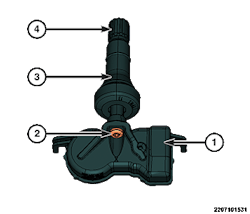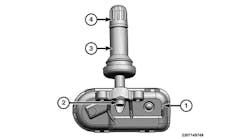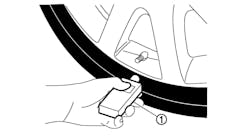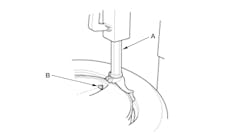Chrysler Pacifica – 2022
DESCRIPTION & OPERATION
DESCRIPTION
The Tire Pressure Monitoring System (TPMS) monitors air pressure in the four road tires. Sensor transmissions occur if there is a significant change in pressure. The Radio Frequency Hub (RFH) module has to be awake when sensor transmits to monitor spare pressure. The system consists of tire pressure monitoring sensors attached to each road wheel through the valve stem mounting hole, an electronic display, and an indicator lamp. The system communicates through the RFH module. The receiver circuit for the TPMS system is integrated into the RFH module. If the vehicle is equipped with remote start, the external remote start antenna receives the signal that the RFH module decodes and the radio frequency signals transmitted by each of the vehicle tire pressure sensors. The decoded information is used to determine if "warning" or "fault" conditions exist within the TPMS system. Upon detection of a warning or fault condition, the RFH module will send a request to the module that controls the indicator lamp and the text display via the vehicle bus system to illuminate or flash the indicator lamp. Also, upon detection of a warning or fault condition, the electronic display will send a request to sound the "chime.”
The RFH module will store all warning and fault conditions, placard pressure values and low-pressure threshold values (lamp ON and OFF) in memory that can be accessed through diagnostic communication. If new sensors are introduced to the vehicle, the data stored for the sensor being replaced will be deleted.
The RFH module will store all wheel sensor IDs and locations and faults in memory that can be accessed through diagnostic communication. All other data values transmitted from each active wheel sensor shall be stored in the RFH module memory.
The RFH module automatically learns and stores the sensor IDs while driving within 20 minutes continuously above 32 km/h (20 mph) after a sensor has been replaced. The learning sequence will initiate when the vehicle has been stopped for more than 20 minutes.
NOTE: A new sensor ID can also be programmed directly into the RFH module by using a RKE-TPM Analyzer in conjunction with a Scan Tool. Once the new sensor ID has been programmed, the RKE-TPM Analyzer can be used to update the TPMS system by activating the sensor.
OPERATION
The TPMS system is designed to operate without loss of function for all OEM tires for this vehicle. Sensors, mounted to each road wheel as part of the valve stem, transmit an RF signal indicating their individual pressure to a receiver located in the RFHM.
If the system detects that the tire pressure in any road tire is low, beyond the Low Pressure (lamp) ON threshold (see placard table below), the TPMS system will continuously illuminate an indicator lamp. If a system fault is detected, the indicator lamp will flash ON/OFF for 75 seconds, then remain on solid.
If the RFH module detects a warning or fault condition at ignition key ON, the display module will request a chime once per ignition cycle for the first "warning" or "fault" condition detected. A "warning" or "fault" condition will remain enabled until the problem causing the condition is corrected and removed/reset.
The RFH module continuously monitors for the receipt of tire pressure RF message transmissions from the wheel sensors for 20 minutes after key OFF. The wheel sensor IDs and the location of each sensor (for example, Tire 1, Tire 2 and others) are stored in the RFH module non-volatile memory during the initial Manufacturing Plant Process (MPP), or during a service procedure, as required.
The TPMS system will continue to warn the driver of low tire pressure as long as the condition exists, and will not turn off the indicator lamp until the tire pressure is at or above the placard. The system will automatically update and the TPMS indicator lamp will extinguish once the updated tire pressures have been received.
Tire pressure will vary with temperature by about 6.9 kPa (1 psi) for every 6.5 degrees Celsius (12 degrees Farhenheit). When the outside temperature decreases, the tire pressure will decrease. Tire pressure should always be set based on cold inflation tire pressure (placard pressure). This is defined as the tire pressure after a vehicle has not been driven for more than three hours (and in outside ambient temperature). The tire pressure will also increase as the vehicle is driven; this is normal and there should be no adjustment for this increased pressure. For a system fault, the system will return to normal once the RFH module receives a valid transmission from that sensor location.
TPMS THRESHOLD PRESSURES
The recommended "placard pressure" for the tires installed on the vehicle are stored in the RFH module non-volatile memory during the initial MPP, or during a service procedure, as required. To determine the pressure thresholds for a vehicle, refer to the Tire Inflation Pressure (Placard) Label, and then apply the placard pressure to the following table. For additional information, refer to the owner's manual or the appropriate diagnostic information.
MEMORIZING THE TIRE PRESSURE SENSOR ID
NOTE: If a TPM-RKE Tool is not available, let the vehicle sit stationary for more than 20 minutes, and then proceed to step No. 4 below.
1) Using a TPM-RKE Analyzer Tool at the most current version available, select TPM Functions, then enter the model year and the body style of the vehicle, and for the Trigger Selection select PARK SENSOR.
2) Scan each TPMS sensor at each road wheel, and store each sensor ID in the correct location, including the spare tire, if equipped.
3)Connect the TPM-RKE Analyzer Tool to the scan tool, and then follow the programming steps outlined in the diagnostic scan tool for "Program Tire Pressure Sensor ID w/ TPM Tool" under "MISC" for the TPMS.
4) Drive the vehicle for a minimum of 20 minutes while maintaining a continuous speed above 24 km/h (15 mph).
5) With the scan tool, read TPMS DTCs.
TIRE PRESSURE SENSOR REMOVAL AND INSTALLATION
REMOVAL
NOTE: When demounting or mounting the tire on the wheel, follow the tire changer manufacturer’s instructions while paying special attention to avoid damaging the pressure sensor.
1) Raise and support the vehicle.
2) Remove tire and wheel assembly and demount the tire from the wheel.
NOTE: Replace the valve stem (3) assembly with each tire change or when the tire is removed from the wheel.
NOTE: Install a new valve stem (3) and valve stem core if they are removed from the wheel or valve stem.
3) To remove the sensor (1) from the valve stem (3), remove the valve stem mounting fastener (2).
4) Remove the valve stem (3) from the wheel.
INSTALLATION
CAUTION: Any time a sensor is to be reinstalled in a wheel, a new valve stem assembly must be installed to ensure airtight sealing.
When installing a new valve stem, do not install it with the sensor attached. If it is a new sensor, separate the valve stem from the sensor first then install the components separately.
Replace the valve stem assembly with each tire change or when the tire is removed from the wheel.
1) Wipe the area clean around sensor/valve stem mounting hole in wheel. Make sure surface of wheel is not damaged.
When installing a new valve stem, water or water/soap solution should be used for proper installation into the wheel.
2) Position the valve stem into the wheel mounting hole, with the flats at a 90-degree angle to the wheels lip, then pull through to seat with a standard valve stem installation tool.
3) Install the sensor onto the valve stem by aligning the flats in the sensor to the flats on the valve stem.
NOTE: When demounting or mounting the tire on the wheel, follow the tire changer manufacturer’s instructions while paying special attention to avoid damaging the pressure sensor.
4) Install and secure the tire pressure sensor to valve stem mounting fastener.
5) Mount tire on wheel and install tire and wheel assembly on the vehicle.
6) Adjust air pressure to that listed on Tire Inflation Pressure Label (Placard) provided with vehicle (usually applied to driver's side B-pillar). Make sure original style valve stem cap is securely installed to keep moisture out of sensor.
7) Remove the support and lower the vehicle.
8) Perform one of the following to make the system learn the new sensor ID:
- Use the TPM-RKE Analyzer, 9936, with the scan tool to program the RF Hub module with the tire pressure sensor ID. This is part of the TPMS Diagnostic Verification Test.
- Once the vehicle has remained stationary for more than 20 minutes, drive vehicle for a minimum of 20 minutes while maintaining a continuous speed above 20mph (32 km/h). During this time, the system will learn the new sensor ID. This is part of the TPMS Diagnostic Verification Test.
NOTE: If a sensor cannot be trained, refer to appropriate diagnostic information.
Torque Specifications
Tire Pressure Monitoring Sensor Torque Specifications
Description N.m In. Lbs.
TPMS sensor 8 71




